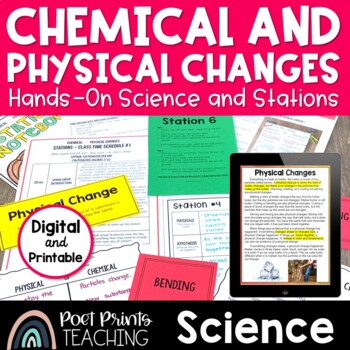Chemical and Physical Changes Stations
- PDF
- Google Apps™

Also included in
- Engage your GRADE 2 students in science units created just for them! This is a BUNDLE of 4 hands-on science units Explore the water cycle, the life cycles of plants and animals, force & motion, and chemical and physical changes! All units are completely aligned to the Grade 2 British Columbia BPrice $33.49Original Price $45.00Save $11.51
Description
Get ready to learn the difference between chemical and physical changes! In this hands-on station based science unit, students will explore chemical and physical changes through fun vocabulary games, direct instruction, whole group learning, and standards-based stations.
The complete unit features detailed teacher instructions all along the way.
What's included in this chemical and physical changes unit?
- Day-By-Day Teachers Guide - A daily lesson breakdown for using all parts of this resource in approximately ten 45-60 minute science lessons! The planning is all done for you. ✏️
- Introductory Worksheets - Introduce students your new topic to your students and remind them of what they know about the different ways materials are changed using the pages in this section of this packet. Choose the page(s) in this section that work best for your class. Have students brainstorm what they already know about chemical and physical changes and do some simple research to discover a little bit more. Try doing this part in pairs or small groups!
- Vocabulary - Vocabulary word wall cards using the major vocabulary from this Chemical and Physical Changes unit. Vocabulary words in this unit include the terms: chemical change, physical change, matter, state of matter, color, temperature, burning, baking, cooking, rusting, melting, cutting, bending, stirring, mixing, freezing, warming. This section also includes a vocabulary worksheet and a fun classroom activity.
- Nonfiction Reading - No Textbook? No Problem! This resource includes 3 pages of nonfiction reading passages. "Chemical Changes" "All About Physical Changes" and "Changes in Real Life" All reading passages also come with accompanying reading response worksheets!
- Teacher-Led Lesson - Work together to create an anchor chart that outlines the difference between chemical and physical changes.
- SCIENCE STATIONS - SIX hands-on stations where students will complete simple experiments and determine if the result is a chemical or physical change. Teacher instructions highlight different ways to set up the stations and a minute-by-minute timeline of each day.
- Station One - Observe a burning candle
- Station Two - Dissolving sugar in water
- Station Three - Explore baking soda and water
- Station Four - Make a trail mix snack
- Station Five - Create a cube craft
- Station 6 - Cleaning old pennies
- Assessments - A unit-end quiz and a complete answer key.
What do I get with my purchase?
- Printable PDF of the Chemical and Physical Changes Unit
- Answer Key
- DIGITAL version in Google Slides
Looking for more BC Grade 2 Science? I've Got You Covered!
Life Cycles of Plants and Animals
This unit is aligned to the British Columbia, BC Big Ideas, Manitoba Science Curriculum, Ontario Science curriculum, and NGSS.
BC Big Ideas
- Materials can be changed through physical and chemical processes.
BC Content
•Physical ways of changing materials
•Chemical ways of changing materials
Manitoba Science Curriculum (Grade 5)
•5-2-09 Explore to identify reversible and non-reversible changes that can be made to substances.
•5-2-10 Recognize that a physical change alters the characteristics of a substance without producing a new substance and that a chemical change produces a new substance with distinct characteristics and properties.
•5-2-11 Observe examples of changes in substances, classify them as physical or chemical changes and justify the designation.
Ontario Science Curriculum (Grade 5)
•3.4. describe physical changes in matter as changes that are reversible
•3.5. describe chemical changes in matter as changes that are irreversible
•3.6 explain how changes of state involve the release of heat
•3.7 identify indicators of a chemical change
•3.8 distinguish between a physical change and a chemical change
NGSS
•2-PS1-4
•MS-PS1-2






